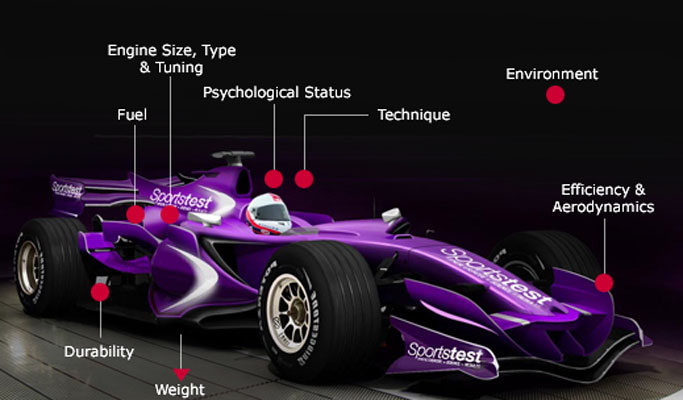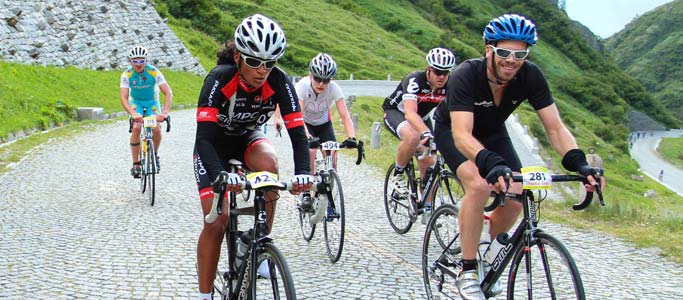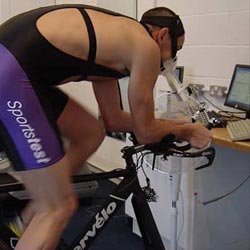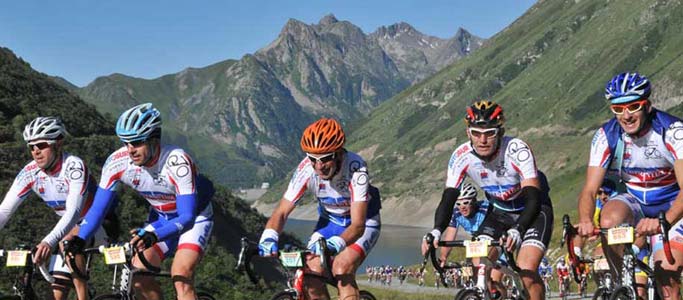If you are not already following a cycling training plan with specific goals then now is the time to start planning. Scientist Dr Garry Palmer from Sportstest takes us through how to approach creating your cycling training plan.
Over to you Dr Palmer:
Do I Need a Cycling Training Plan?
Although there is no magic formula to success, I intend to give you a background that should assist with the structure and organisation of training. In this article I will examine the rudiments of why we cycle and give you a background to build structure into your training.
To help visualise the many factors that influence the performance of a cyclist, consider a Formula 1 motor racing car. Before each race many preparations are made to the car to ensure peak performance is achieved. The driver is fully rested and psychologically prepared for the gruelling event, the engine is renewed and highly tuned, the fuel tank filled with high performance fuels, the body work adjusted to achieve optimal aerodynamics, and the weight reduced without affecting the many safety features of the car. All of these are important to aid performance.

Dr Garry Palmer from Sportstest takes a holistic approach to the cycling training plan
In the same way the athlete is that racing car. The frequency and duration of training determines the capacity and ability of their engine, the food eaten affects the fuels utilised, and the riding position and bike’s maintenance determines aerodynamics and mechanical efficiency.
As sportsmen and women the first question must be: Why do we do it? Invariably the answer will be to participate for fitness, improved health, or just for enjoyment. Although this may be true, most athletes ultimately wish to improve their performance (whether it be to just to finish a Sportive, or to look to improve previous performance, or even win an event!). However, each individual must decide how important achievement is, and integrate sport into their lives accordingly.

The unique Granfondo Gottardo is an excellent sportive to have as an aim in your cycling training plan
Cycling Training Plan Tips: Set Goals
With this in mind, to achieve the maximal benefits of training, organisation and planning is required. One of the first steps towards organisation of any training program is to identify goals. These goals should be short, medium and long term, giving direction and focus.
An example of a short term goal could be undertaking regular bicycle maintenance (especially important in these winter months), whilst a long term goal may be to complete the desired event at a certain level. The goals set must be achievable with effort, and should be reviewed regularly and altered where necessary.
Another important step towards organisation of training should be to identify and list any weaknesses. At Sportstest we are able to do this accurately through a carefully controlled performance assessment, which also clearly determines heart rate and power training zones. Once identified, work to reduce any factors limiting performance can begin.
For example, during a low intensity training session an athlete may utilise his/her time more efficiently by working on their ability to descend or corner at speed, or may concentrate on style and position on the bike. An individual who feels they are weak on climbs may spend an entire session doing hill repetitions to improve their climbing ability. In this way a simple goal is set for each ride and all training sessions are planned to achieve a medium term goal.
Cycling Training Plan Tips: Structure
The conscientious athlete will build a training regimen that plans from day to day. From this a training routine may be structured to ensure all important sessions are undertaken, whilst still obtaining adequate rest, within a 7, 10 or 14 day period. In this way an individual will develop a carefully planned training program.
The next stage for an athlete would be to plan phases in his/her program to build up to an important event. Again each phase should have a specific goal, for example to build endurance, to enhance base speed, or to recover following a particularly hard period of training.
Another way to improve training structure and enhance performance is to keep a training diary. This type of information will be of benefit in the long term. Many athletes find a diary useful to learn about their training by reviewing its positive and negative aspects, and planning future training accordingly.
It is obviously up to the individual what is recorded in their training diary. However, information of use may include: training duration and intensity; weather; possibly some sort of “feel good” rating; food and drink consumed before and during the ride; resting morning heart rate; and weekly body weight. In this way a diary may help identify practices (such as feeding) beneficial to performance, or possible act as an early warning to looming problems.
With some simple planning to utilise these suggestions an athlete should be able to add some structure to enhance their training program and optimise the building and fine tuning required for their “engine”.
Cycling Training Plan Tips: Mechanical Efficiency
In order to gain the maximum benefit from the efforts of training, the conscientious athlete will also pay attention to aerodynamics and mechanical efficiency. By simply reducing frontal area, and therefore reducing drag, a rider will use less energy to maintain a fixed pace. The same is true of “drafting”. Thus, by simply paying attention to position, or ill-fitting clothing, aerodynamic benefits may be gained. Some athletes find a bike fit or video analysis a useful method to check their bicycle set-up and monitor riding position and style.
Sportstest are partners with Bespoke Cycling’s Fitting Studio where the Retül 3D motion capture system is used to get the best possible bike fit for you as an individual.
Mechanical efficiency can be optimised with correct bike set-up. However, many athletes lose these benefits with poor bike maintenance. Common faults are worn tyres that puncture easily, rusted or dirty chains, and “untrue” wheels. Although tiresome, frequent maintenance of a bike may, in the long run, be both cost effective and help achieve performance goals.
Finally, safety is an issue that should concern all cyclists. A dead or injured cyclist is not fast. Never overlook safety issues: Always wear a secure fitting hard-shell helmet and padded gloves; Wear bright, well-fitting clothes (layers of clothing will reduce grazing following a fall); Always wear reflective clothing and use fully charged lights after dark, and; Always ride with care, caution and courtesy.
In this article Scientist Dr Garry Palmer from Sportstest looked at a few things that may help you in your cycling training plan. You may think some points are obvious, whilst others may not be. However, the main aim of this article is to make you think about, and possible challenge, your present training practices.
And remember it all starts with setting a big scary target.
Sportive Training Plan
Are you in training for a sportive? Use our free 12 week Sportive Training Plan to get you in the best possible shape for your sportive challenge. Simply fill the form below and we’ll send you your free training plan:
[hr]
Photo Credits: Sportstest and Sportograf


